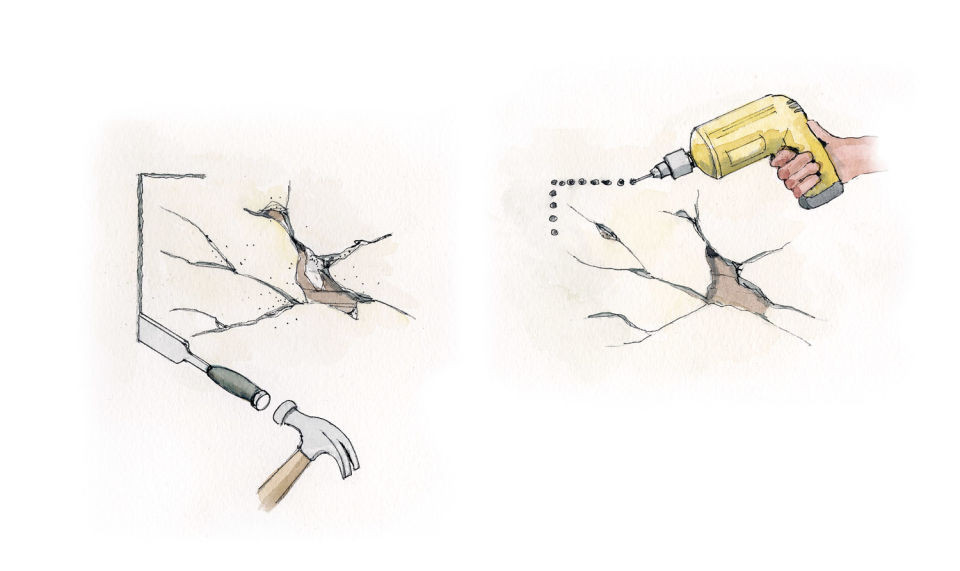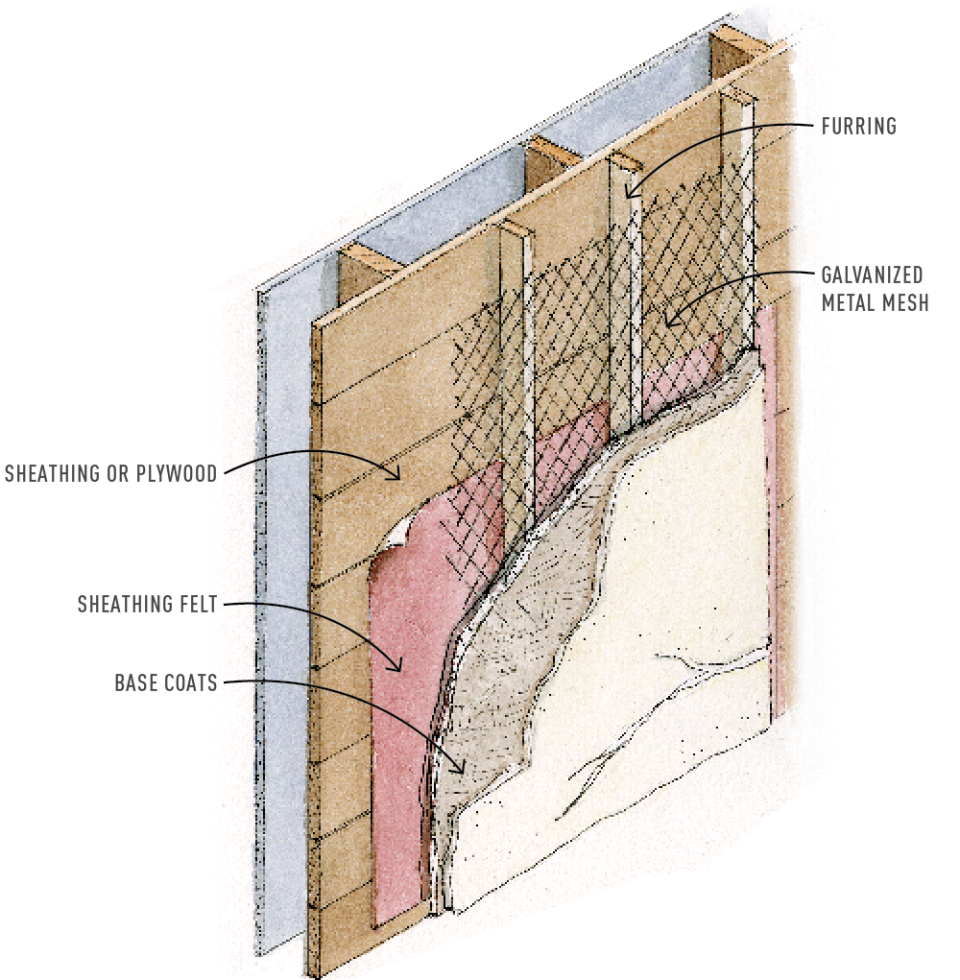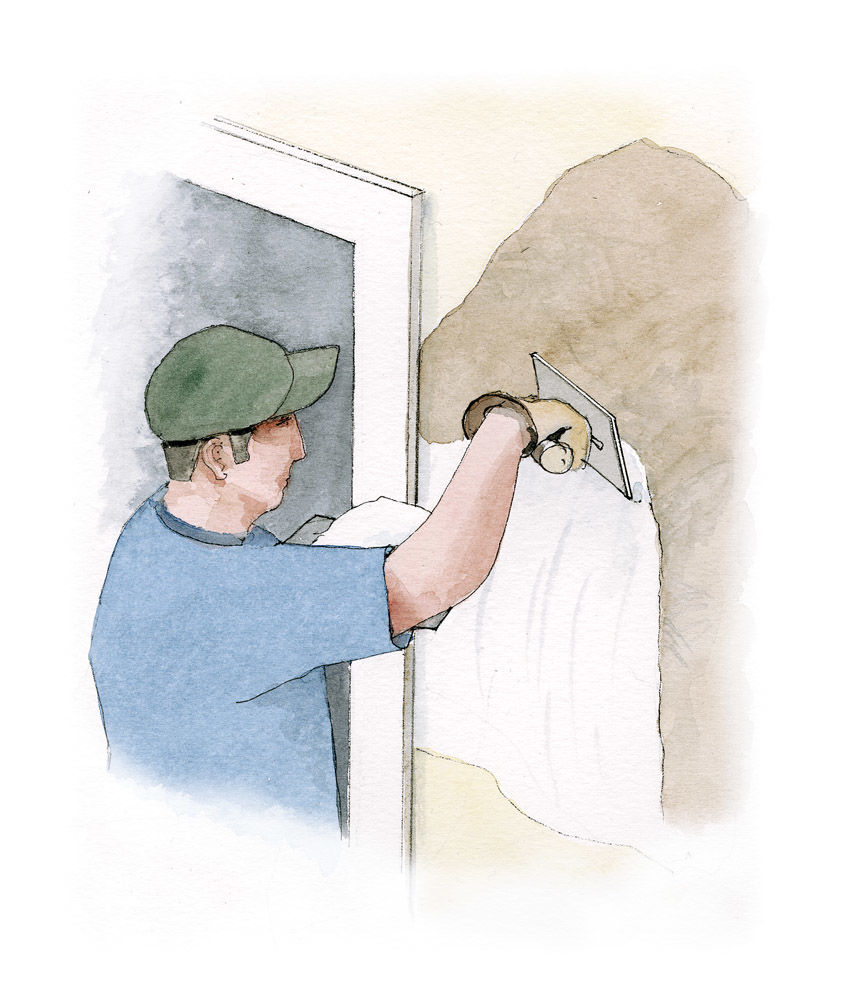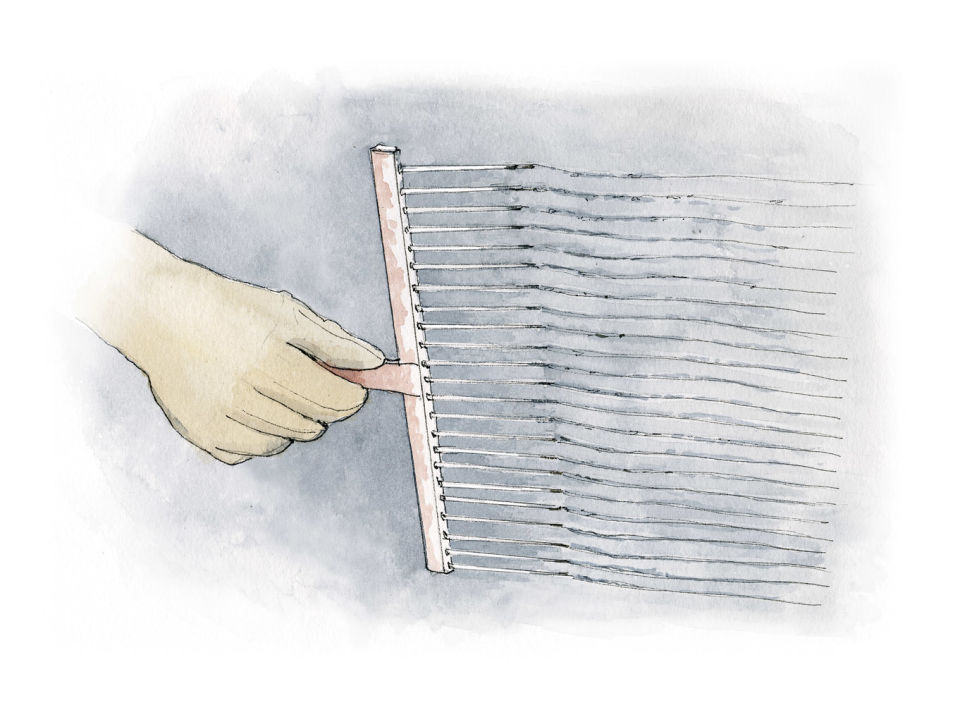Illustrations by Rob Leanna
Stucco made with Portland cement was an exterior finish of choice for many houses built in the 1920s. (Stucco prior to 1900 normally was lime-based.) The cementitious material could be tinted various colors, and given a textured finish that might be smooth or coarse depending on the aggregate in the mix: sand, pebbles, or mica. Stucco typically is applied over wood lath or metal mesh, although the substrate might be masonry.
Despite its durability, even Portland-cement stucco can deteriorate. Spalling, bulging, and cracks need to be addressed to maintain the integrity of a stuccoed exterior. Before beginning a patching project, watch the weather. Overcast (not rainy) days are your friend. Too much sun, or harsh weather, may prevent the mortar from curing correctly. For further protection from the elements, consider covering patched areas with a tarp.

Use a chisel or a series of small drilled holes to outline the damaged area before removing bulging or cracked stucco.
STEP 1
Before patching damaged areas, find and correct the underlying problem causing deterioration. Determine how much stucco needs to be removed. Loose stucco often bulges and feels spongey to the touch. Tap gently with a wood or acrylic hammer on the wall and listen—weak keys will sound hollow, while intact keys send back a solid sound. Use a chisel, or create a series of holes with a drill, to outline the hollow areas. Don’t just pull off loose stucco because secure sections may come off as well. Cut out the area to be patched with an angle grinder fitted with a diamond cutting blade. Go only as a deep as the thickness of the stucco. Pry off the loose piece. Remove only as much stucco as you can patch in a day, so that the area isn’t left exposed.

STEP 2
How are the lath, structural members like the sill, and the insulation? Repair any damage and, if needed, shore up structural members. To replace rotted lath, use plywood cut to fit. Staple water-resistant sheathing felt over the plywood. Attach furring strips over the felt. Nail galvanized metal mesh to the furring strips. The mesh will act as lath.

Applying the finish coat with a metal float.
STEP 3
Determine the type of mortar that matches the original stucco. Mix 1 part Type N mortar to 3 parts mason’s sand in a bucket. Keep the mixture amount small—only enough for an hour’s work—because partially set mortar can’t be used. Apply the scratch coat: a 3/8“-thick first coat of mortar. Mortar is worked into the mesh lath with a trowel and hawk, and then smoothed with a screed. Because the mortar contains no bonding agent, swipe a 6” plaster/stucco scarifier across the mortar; the scratches help create a bond with the next coat. Let dry for 24 to 48 hours.

Using the scarifier.
STEP 4
Lightly mist the scratch coat, including the original stucco edges, with water and a bonding agent. Next, apply the brown coat; it’s usually the same formula for the base coat with 1 part bonding agent to 4 parts water, but check the manufacturer’s directions. Multiple coats may be required to match the thickness of the original stucco. Each coat should be 1/4” to 3/8“, no more. Allow each coat to dry 24–48 hours.
The finish coat will make the patch level with original stucco and match its texture. Mix packaged stucco mix (such as Conproco or Quikrete) as directed. As you apply the finish coat, feather the edges of the patch, but don’t overlap the old stucco. Modern stucco mixes are colored with tints. Experiment with colors as well as mix-ins to match the original texture. Lightly mist the stucco as it cures over 24 hours; protect from strong sunlight and rain with a tarp.
Stucco Types
Because of its durability, fire resistance, and low-maintenance qualities, stucco has long been used as an exterior finish, starting with the Romans and continuing to this day. Two types commonly found on American old houses are lime stucco and Portland-cement stucco. The two are not interchangeable. Lime stucco, flexible and less prone to cracking, is composed of sand, water, and slaked lime as well as an aggregate for texture. Portland cement is a mixture of cement, sand, water, and slaked lime, with the addition of an aggregrate. It, too, is durable and versatile, but hardens more than lime stucco and can be brittle.
For either type of stucco, the texture of the finish coat may come from mix-ins including sand, mica, or pebbles. (Lime stucco often includes animal hair.) The best matches for your original stucco will come from local sources; check local quarries for sand and small pebbles that may blend in. Do test patches until you get a match. Stucco may be painted, but also may be tinted before it is applied.
When repairing stucco, use the type that matches the original. To determine which it is, mix one part muriatic acid with 10 parts water in a lidded glass or plastic, acid-resistant jar, and drop a chip of the stucco into it. Close the lid tightly and shake. Lime stucco dissolves in acid, Portland cement does not. Caution: When working with muriatic acid, wear gloves, goggles, and protective clothing. Work outdoors because of the fumes. Pour the acid into the water, never the reverse.
What causes stucco damage
Water causes most stucco failures. Improper mixing of mortar, bad installation, house settlement, and weather also contribute. Unchecked water dripping where it shouldn’t will cause stucco to delaminate, creating bulges and cracks. Wood lath rots and warps; metal lath corrodes.
Sources of water include rain from overflowing gutters or backsplash, wicking from the ground, leaky plumbing, and vapor migration from inside the house. Find the solution: Repair gutters, drip edges, and flashing; add a vapor barrier; fix leaky plumbing; mitigate the capillary action of groundwater.
Settling is the most common cause of cracks; poor initial installation and seismic activity are others. Investigate to find the reason for cracks that grow or change direction. For foundation problems, a professional assessment may be needed. For hairline or stable cracks, proceed with the repair.







